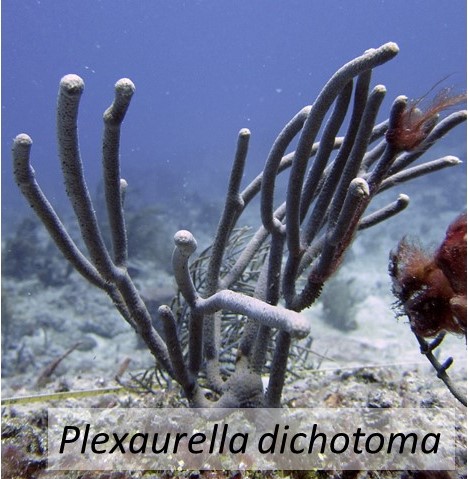
Family: Plexauridae
Common Name(s): Double-forked plexaurella
Colony Form: Colonies moderately branched, bushy, to 1 m tall.
Axis: Extensively mineralized by high-Mg calcite; crescent-shaped rods of calcite to 5 mm long embedded longitudinally in the gorgonin (Bond et al. 2005).
Branches: Moderately robust, dichotomous, 7-18 mm across, with rigid, blunt ends; straight, 15-25 cm long, or shorter and crooked depending on habitat.
Apertures: Distinctly slit-shaped, 1 - 1.5 mm long; calices usually slightly raised to form hemispherical mounds, but may be flush with surface.
Mucus: None
Color: Tan, yellowish brown. Often dries yellowish.
Sclerites: Polyp armature: few tiny rods with weak processes. Axial layer: spindles, triradiates and quadriradiates ~0.3 mm long. Middle layer: straight and bent spindles, triradiates, and quadriradiates with strong tubercles, all ~0.35 mm long. Surface layer: small 6-radiate capstans, chiefly 0.1 mm long, many with two rays enlarged.
Habitat: Less common inshore; common on patch reefs and outer slope and fore reefs, in 3-49 m depth.
Distribution: South Florida, Bermuda and throughout the Caribbean.
Notes: Growth rate 0.80 cm/yr (Yoshioka et al. 1991, lower than any other octocoral reported) Distinguished by stout quadriradiate and coarsely sculpted triradiate spicules in the middle cortex (Bayer 1961, Keith 1992). Can have nearly identical and overlapping variation of sclerites with P. fusifera, although the two are generally distinguished by external features (Sánchez and Wirshing 2005). Preyed upon by the generalist octocoral predatory snail Cyphoma gibbosum, but also by Cyphoma signatum, a specialist predator on Plexaurella spp. (Ruesink and Harvell 1990).
Similar Species: Plexaurella fusifera; Plexaurella nutans









